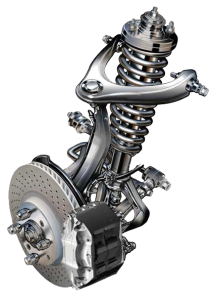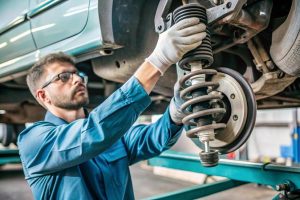Your vehicle’s suspension system does far more than just smooth out bumps — it ensures stability, precise steering, and consistent tire contact with the road. Over time, even the best suspension components wear down due to constant stress, road conditions, and environmental factors. When that happens, repairs can range from minor fixes to major replacements.
Understanding the true cost of suspension repairs helps drivers prepare financially and make informed maintenance decisions. Below, we break down the key factors affecting costs, common components that fail, and practical tips for budgeting effectively.
What the Suspension System Includes

A typical car suspension system is made up of several interconnected components. Each plays a role in absorbing shocks and maintaining balance.
| Component | Function | Typical Lifespan (km) |
|---|---|---|
| Shock absorbers / struts | Dampen road impacts and control bounce | 80,000–120,000 |
| Springs (coil or leaf) | Support vehicle weight and maintain ride height | 100,000–160,000 |
| Control arms & ball joints | Connect wheels to frame, allowing up/down motion | 80,000–120,000 |
| Bushings | Isolate vibration and reduce noise | 80,000–100,000 |
| Sway bars & links | Minimize body roll in corners | 60,000–100,000 |
| Rear suspension components | Maintain rear axle alignment and stability | 100,000+ |
If one part wears prematurely, others may soon follow — making timely inspections and replacements essential.
Factors That Influence Suspension Repair Costs
The overall cost of repairing or replacing suspension components depends on several key factors:
-
Vehicle Type – Luxury, SUV, and performance vehicles often have more complex systems and costlier parts.
-
Suspension Design – Air or adaptive suspension systems are more expensive to fix than traditional coil or leaf setups.
-
Extent of Damage – Minor wear (like bushings) costs far less than replacing control arms or struts.
-
Labor Rates – Costs vary by region, ranging from €50 to €150 per hour in Europe.
-
Part Quality – OEM components are typically more expensive than aftermarket alternatives, though they often offer better longevity.
Average Suspension Repair Costs by Component
| Repair Type | Average Cost Range (€) | Notes |
|---|---|---|
| Shock absorber / strut replacement (per axle) | 250–600 | Includes parts and labor |
| Coil spring replacement (pair) | 200–400 | Common in rear suspension systems |
| Control arm replacement | 300–700 | Often includes new bushings and ball joints |
| Ball joint replacement (per wheel) | 150–300 | Labor-intensive on some vehicles |
| Sway bar link replacement | 100–200 | Usually replaced in pairs |
| Rear suspension rebuild | 500–1,200 | Can include springs, links, and bushings |
| Air suspension compressor or bag | 600–1,500 | Luxury or SUV models only |
These figures are general estimates — prices vary widely depending on make, model, and labor market.
For quality replacement parts, you can Buy Suspension online to ensure you’re getting OEM-grade or high-performance components that match your vehicle’s requirements.
Warning Signs That Indicate Suspension Problems
Ignoring early symptoms can turn small issues into costly repairs. Be alert to the following warning signs:
-
Uneven or excessive tire wear
-
Vehicle pulling to one side
-
Clunking or knocking sounds when driving over bumps
-
Nose-diving during braking
-
Poor steering response or excessive body roll
-
Noticeably rough or bouncy ride
If any of these appear, have your suspension inspected immediately to avoid further damage.
How to Budget for Suspension Maintenance
To prevent financial surprises, plan for suspension maintenance as part of your overall vehicle ownership budget.
Recommended Budget Breakdown:
| Category | Suggested Budget (€ per year) | Description |
|---|---|---|
| Routine inspections | 50–100 | Every 10,000–15,000 km |
| Minor part replacements (bushings, links) | 100–200 | Typically every 2–3 years |
| Major suspension repairs | 400–800 | Every 4–6 years |
| Upgrades or performance tuning | 500–1,000 | Optional, for enthusiasts |
Budgeting Tips:
-
Set aside at least 5–10% of annual vehicle costs for suspension-related maintenance.
-
Always replace components in pairs or sets to maintain balance.
-
Don’t delay small repairs — ignoring a €100 bushing issue can lead to a €600 control arm replacement later.
-
Consider sourcing parts yourself (from verified suppliers like Elart) and paying only for professional installation.
DIY vs. Professional Repairs
| Option | Pros | Cons |
|---|---|---|
| DIY Repairs | Cost savings, hands-on experience | Requires tools, mechanical knowledge, and safety precautions |
| Professional Repairs | Warranty, correct installation, faster turnaround | Higher labor cost |
While some small jobs (like sway bar links or bushings) can be handled by experienced DIYers, complex repairs involving alignment or hydraulic systems should always be done by certified mechanics.
How to Extend Suspension Lifespan

Proper maintenance can double your suspension’s life and prevent costly breakdowns.
Maintenance Checklist:
-
Inspect suspension components every 20,000 km.
-
Rotate and balance tires regularly to reduce uneven stress.
-
Avoid overloading the vehicle.
-
Wash undercarriage to prevent corrosion, especially in winter.
-
Replace damaged boots and bushings promptly.
-
Use OEM or high-quality aftermarket parts from trusted suppliers — for instance, you can Buy Suspension online for reliable replacements.
Air and Adaptive Suspension: A Special Case
Modern luxury and performance cars often use adaptive or air suspension systems, offering superb comfort and control but at a premium.
| Component | Typical Cost (€) | Common Failure Cause |
|---|---|---|
| Air spring (per corner) | 300–800 | Rubber air bladder leaks |
| Air compressor | 600–1,000 | Moisture buildup or wear |
| Ride height sensor | 100–250 | Electrical faults |
| Control module | 300–700 | Software or circuit issues |
These systems require specialized diagnostics and repairs, which can significantly raise total suspension service costs.
Final Thoughts
Suspension repairs can seem expensive, but neglecting them costs far more in the long run — in tire wear, fuel efficiency, and safety risks. A properly maintained suspension system ensures stable handling, shorter braking distances, and a more comfortable drive.
By planning ahead, monitoring component wear, and investing in high-quality replacements, you can manage costs effectively and enjoy smoother, safer journeys.
For dependable replacement parts and performance upgrades, explore Buy Suspension online — your reliable source for premium suspension components, from springs and shocks to full rear suspension assemblies.